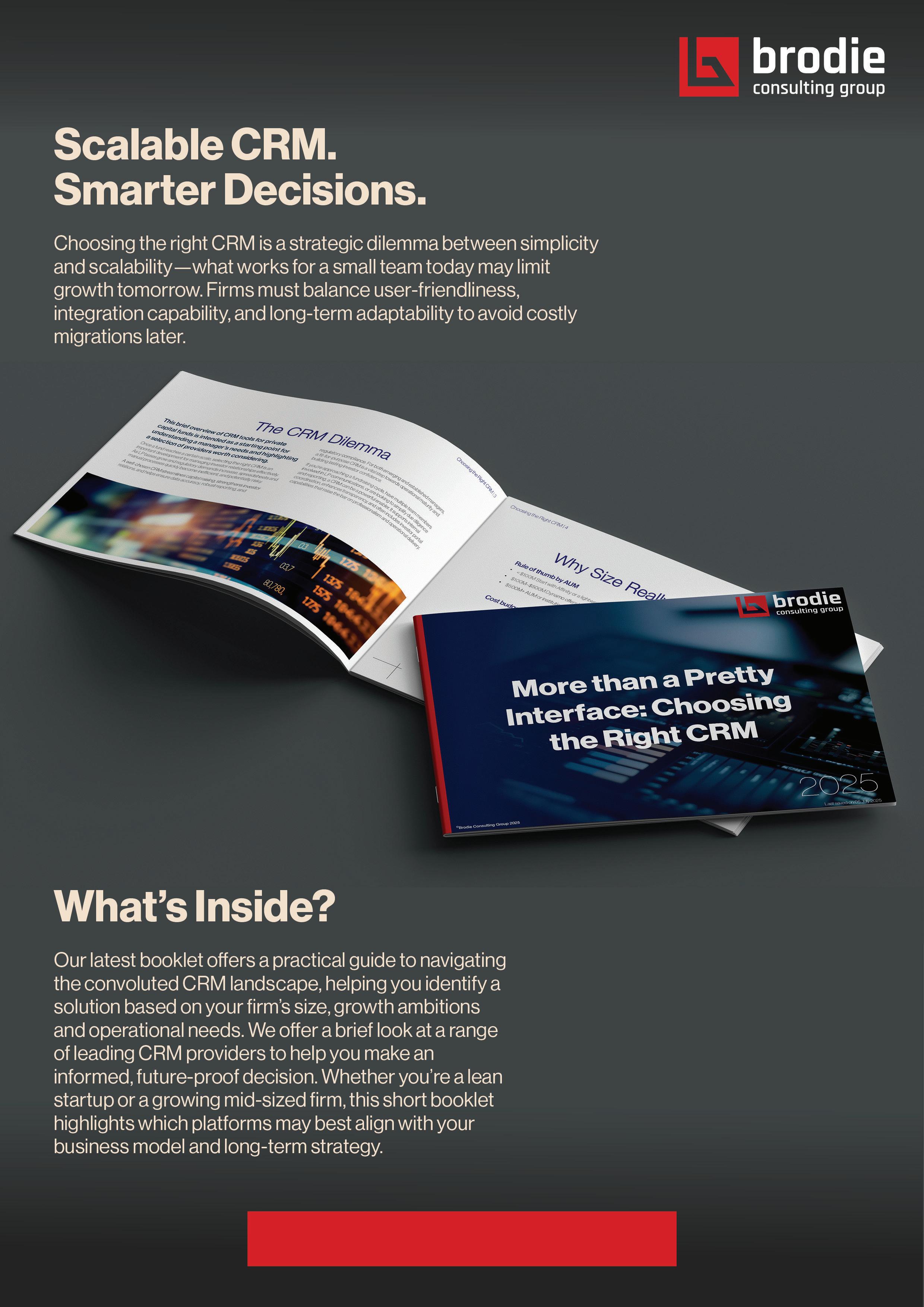

Shifting sands: the emergence of private credit as a standalone asset class
In an increasingly competitive private credit market, our guest writers highlight the need for sharper focus and differentiation. Federated Hermes' Patrick Marshall underscores the value of exclusive bank partnerships in securing high-quality, off-market deal flow. Dechert's Nathalie Sadler notes that while evergreen funds offer structural advantages, they bring operational and regulatory complexity as they shift from optional to expected. Zugzwang's Kunal Khanna argues that with returns compressing, alpha will come from niche areas such as specialty lending and underserved geographies.
Bite Stream's Didier Lambriex adds that as the asset class matures, operational excellence - clear communication, real-time data, and disciplined execution - is as critical as credit selection. In Opinion, Renown Capital's James MacIntyre makes the case for a generational investment opportunity in energy technology solutions - often overlooked - amid soaring demand, supply instability and fragmented transition. In Letter from America, Prosek Partners' Mark Kollar explores how shifting geopolitical priorities and record-breaking defense budgets are driving a private market pivot toward defense investments.





Hedge Funds Rally as Equity and Event Strategies Lead
June markets rode a volatile mix of geopolitical disruption, shifting central bank policies, and surprising investor resilience, conditions under which hedge funds delivered strong performance. Read our full market review. Nearly all strategies ended the month in positive territory, with the HFRI Fund Weighted Composite Index rising 2.4%.
Equity Hedge strategies led the way, with the HFRI Equity Hedge (Total) Index up 3.4%.
Technology exposure was a standout, as the Technology Index surged 7.1%. Other strong performers included Fundamentals/Growth (+4.7%) and Energy/Basic Materials (+3.7%).
Event-Driven managers also posted strong returns, with the HFRI Event-Driven (Total) Index up 3.2%. Within the sector, Special Situations led (+5.2%), followed by Multi-Strategy (+4.6%) and Distressed/Restructuring (+2.7%). Activist strategies lagged slightly, gaining 1.4%.
Macro proved more challenging, with the HFRI Macro (Total) Index returning a modest 1.3%. While large macro trends were in play, the unpredictable nature of policy shifts and geopolitical developments made for tricky conditions. Discretionary Macro managers gained 2.6%, while Systematic approaches posted a more subdued 0.8%. Currency managers were among the few in negative territory, down 0.2%.
In Relative Value, the HFRI Relative Value (Total) Index rose 0.8%. The standout was Yield Alternatives, up 1.9%, followed by Multi-Strategy (+1.3%) and Fixed Income – Corporate (+1.0%). The Volatility Index, however, declined 0.5%.
Regionally, MENA was the best performer, up 3.8%, followed by Latin America and North America (both +2.9%). China closed in the red, finishing the month down 0.5%.

Arlington Capital Locks In First Close
Arlington Capital Partners held the first close for its seventh flagship fund, Arlington Capital Partners VII, reportedly securing over $2.5 billion toward a multibillion-dollar target. The Washington DC firm focuses on investments in government services, aerospace, defence, healthcare and industrial technologies, sectors characterised by high regulatory barriers and mission-critical operations. The fundraise follows the successful deployment of the $2.2 billion Fund VI, which closed in 2022, and includes a mix of returning LPs alongside new investors.
Recognize Closes $1.7bn Fund
Recognize closed its second fund, Recognize Partners II, with commitments totalling $1.7 billion, surpassing the $1.3 billion raised for its debut fund. The firm, founded in 2020 by Frank D’Souza, Charles Phillips, David Wasserman and Raj Mehta, specialises in backing mid-market technology services companies, particularly those driving digital transformation across industries. The new fund reinforces the firm’s focus on opportunities across IT services, cloud computing, data analytics, and digital engineering, as it looks to build marketleading platforms in a sector that is undergoing rapid change and consolidation.
Cinven Targets Sector-Led Mid-Market Fund Launch
Cinven launched a new mid-market private equity fund, Cinven Strategic Opportunities Fund II, targeting between €1.5 billion and €2 billion. With fundraising efforts starting in June, the new vehicle focuses on financial and tech-enabled services, marking a strategic evolution from Cinven’s 2022 Strategic Financials Fund. With a sharpened sector focus and expanding mandate, the fund aims to capitalise on growth opportunities in specialised finance and technology-driven business models. The effort is being led by newly appointed partner Michael Weber. The new fund underscores Cinven’s intention to capture attractive mid-market deal flow amid ongoing institutional high demand for sector-specialist strategies.


Morgan Stanley Closes Mid-Market Fund Launch
Morgan Stanley Capital Partners closed its latest private equity fund, North Haven Capital Partners VIII, at $3.2 billion, exceeding the original target of $2.5 billion and the $3.0 billion hard cap. The fund closed on 23 June 2025, less than a year after its first close in Q3 2024. Backed by institutional investors, family offices, and Morgan Stanley Wealth Management clients across the Americas, Europe, and Asia, the fund focuses on US middle-market investments. Approximately 17% of capital has been deployed into three companies, spanning property restoration, nutritional supplements and industrial boiler services. The close follows the successful $2.0 billion raise for Fund VII in 2021.
BharCap Raises Fund to Back North American Financials
BharCap Partners, which spun out of Pine Brook Partners in 2020, closed its second financial services-focused fund, raising $1.1 billion in total commitments - a 50% increase over its debut fund. The capital pool comprises $652 million in primary fund commitments, alongside an additional $460 million in co-investment capital, providing
substantial scale for pursuing control-oriented investments across the North American insurance, specialist finance and related subsectors. The upsized fundraise reflects growing LP confidence in BharCap’s focused strategy and execution track record in the financial services space.
Marlin Hits Hard Cap
Marlin Equity Partners closed Marlin Heritage Europe III at its €1 billion hard cap, marking a significant step in its European expansion strategy. The fund was oversubscribed and raised more than 50% above its predecessor. The vehicle, managed by the London team, continues Marlin’s focus on investing in high-potential European software, technology and services companies, with several initial investments already completed in firms such as Treasury Intelligence Solutions, Radar Healthcare, Napier AI and Didomi. The close reinforces Marlin’s 20-year track record and growing presence in the European midmarket.
Seaside Equity Nears $720m Raise
Seaside Equity Partners is in the final stages of raising two new US buyout vehicles with a combined target of $720 million. The vehicles, Seaside Equity Partners III and Navigator I, continue the San Diego firm’s focus on US lowermiddle-market private equity transactions, primarily targeting founder-led businesses across business services, industrials and healthcare.


UPDATES (cont.)
Ares Raises Japan Data Centre Fund
Ares Management closed its inaugural Japan DC Partners I LP raising $2.4 billion. The fund is underwriting the development of three campus-style data centres in Greater Tokyo, delivering nearly 240 MW of IT load powered by renewable energy and innovative cooling systems. Backed by a team of over 70 professionals
OPINION
and strong local capabilities and enhanced by the integration of Ada Infrastructure - its dedicated global data infrastructure platform (acquired from GLP) - Ares is deploying capital alongside CPP Investments and GLP to address the fast growing demand from AI and cloud applications.

The Investment Opportunity Within the Changing Energy Landscape
When it comes to the global energy system, one thing is undeniable: the landscape has never been more complex. And with complexity comes opportunity.
In 2025, we sit at the convergence of a perfect storm of factors: rising (in some regions soaring) electricity demand, new and unpredictable usage patterns, distributed energy resources, and supply chain instability. These elements are rattling governments, regulators, and utilities, as well as consumers who are already beginning to experience higher bills alongside less reliable service.
Why is this happening now? Electricity consumption is rising globally - even in areas that for generations have seen flat to declining demand - due to the proliferation of energyintensive data centers, accelerating industrial production, and extreme weather. The International Energy Agency forecasts that demand will increase by 3,500 TWh annually between 2025-2027, equivalent to adding Japan’s entire consumption each year.
At the same time, there is a push toward greater integration of distributed energy resources and cleaner generation. This is the backbone of what has traditionally been thought of as “the energy transition.” While billions of dollars have been invested in physical assets like wind turbines, solar farms, and electric vehicles, the crucial digital infrastructure required to integrate and
optimize these assets has lagged far behind. It’s akin to building a cutting-edge smartphone without investing in a reliable cellular network: no matter how advanced the device may be, it is limited by the platform on which it operates.
Despite all of this, there is ample reason for optimism. Paradoxically, modern technologies have contributed to greater energy usage – but they are also what will help us to finally transform the system. These technologies represent one of the most compelling investment opportunities of our time. While BloombergNEF estimates that a physical overhaul of the global electric grid would cost a staggering $21 trillion (an academic point, since supply chain issues would prevent such a project) innovative technology solutions can make a difference today – and for a fraction of that cost.
Though often operating behind the scenes, technology solutions are critical – not only for achieving a successful energy transition but also for driving economic growth, strengthening national security, and unlocking digital innovation. From an investment perspective, this represents a generational opportunity to back solutions that will build lasting value while at the same time addressing foundational global challenges.
James McIntyre, Co-Founder & Managing Partner, Renown Capital Partners

UPDATES
Neuberger Berman Raises $4bn for GP-Led Secondaries
Neuberger Berman closed NB Strategic Capital Fund II, a GP-led secondary vehicle, with over $4 billion raised, surpassing the $2.5 billion target and significantly exceeding its $955 million predecessor, which was closed in 2020.
This fund is one of the larger
continuation fund closings to date, reflecting the growing demand for liquidity solutions amid the subdued dealmaking environment.
In total, Neuberger has already executed more than 40 continuation deals worth a combined $15 billion, with the new fund expected to invest
across 50 to 100 portfolio companies, allowing the firm to take larger stakes without relying on syndicates. This close brings Neuberger’s private assets platform to $135 billion, with around $20 billion now allocated to secondary strategies.

Blechner Eyes $500m for Fund
Yves Blechner, the veteran credit investor from Man GLG, BlackRock, and Davidson Kempner, is launching a new hedge fund named 44 Hill Capital Management in London. The fund will focus on global credit opportunities, including high-yield, special situations, and distressed debt, with a strategy centred on building a concentrated portfolio of what he sees as the most compelling credit ideas. Blechner aims to raise $500 million by November 2025 to support the launch, targeting institutional investors drawn to differentiated, active credit management.
Tikehau Launches Article 8 Defence Fund
Paris-based Tikehau Capital launched an Article 8 private equity fund Tikehau Défense et Sécurité under the EU’s Sustainable Finance Disclosure Regulation.
Structured as a Specialized Professional Fund (SPF) under ELTIF 2.0, this strategy targets investments across defence, cybersecurity and homeland security in Europe. The fund is managed by Tikehau’s dedicated aerospace, defence and cybersecurity team of 30 professionals, who have already deployed capital into over 30
companies since 2021.
Backed initially by Société Générale Assurances, CNP Assurances and CARAC Group, each committing €50 million, the fund is structured via life insurance wrappers and long-term savings products. Tikehau positions this launch as a blueprint for funding strategic industries while meeting ESG standards.

Ares Launches European ELTIF
With investor demand for private credit surging, projected to reach nearly $2.8 trillion by 2028, Ares Management has launched its European Strategic Income ELTIF under the EU’s revamped ELTIF 2.0.
This semi-liquid vehicle provides
high-net-worth investors with access to Ares’s €77 billion European direct lending platform, offering exposure to senior secured floating-rate loans across Western Europe with lower entry thresholds than traditional funds.
ELTIF 2.0 reforms expanded asset
Apollo Delivers £4.5bn Private Credit Lifeline
As private credit cements its role in mainstream infrastructure financing, Apollo Global Management, Inc. is stepping in with a £4.5 billion unsecured loan to support the Hinkley Point C nuclear power plant in the UK, filling the gap left by China’s departure in 2023.
The scope of this deal underscores the expanding reach of private credit into large-scale, strategic energy projects, which have traditionally been the preserve of banks or public bond markets, and highlights how private capital
eligibility, removed previous minimum investments, and boosted liquidity, prompting several major managers - including BlackRock, Amundi and JPMorgan - to follow suit.

now plays a vital role in delivering national, low-carbon infrastructure.
For institutional investors, deals of this scale demonstrate both the growing appetite for stable, longterm returns and the increasing willingness of governments to turn to private capital for critical public projects.
Carlyle & UBS Debut Semi-Liquid Secondaries Platform
UBS’s Unified Global Alternatives (UGA) platform and Carlyle Group partnered to launch a new open-ended private equity secondaries fund, targeting high-net-worth and wealth management clients. The fund offers quarterly liquidity and focuses on diversification and accessibility, and combines Carlyle AlpInvest’s global
secondaries expertise with UBS’s extensive distribution network.
The strategy reflects the rising popularity of secondaries, driven by pricing efficiency and portfolio rebalancing needs, while also playing a key role in broadening access to the asset class for sophisticated retail and semi-institutional investors.


(cont.)

Family Offices Double Down on Alts—But Fees Bite
According to BlackRock's Family Office Report 2025, family offices continue to show a strong appetite for alternative assets, which now make up 42% of their portfolios, up from 39% in the previous survey. Private markets remain particularly attractive due to their potential to deliver illiquidity premia, differentiated returns and resilience during public market volatility. Within this space, private credit and infrastructure are gaining momentum, with 32% and 30% of family offices, respectively, planning to increase allocations to these asset classes over 2025–2026. However, despite growing interest, high fees remain a key barrier, flagged by 72% of respondents as a significant challenge.
Hedge Funds See $6bn Net Inflows in May
Citco-administered hedge funds recorded net inflows of $6.0 billion in May, one of the strongest monthly fundraising periods in recent years. Gross subscriptions totalled $17.4 billion, with redemptions at $11.4 billion, reflecting broad allocator confidence despite ongoing macro uncertainty. Continuing the ongoing theme of flows to multi-strategy, these vehicles accounted for the bulk of inflows (+$7.3 billion), benefiting from their diversification across asset
classes and structural resilience. Equity long/short and hybrid funds each attracted approximately $1.2 billion, while global macro (-$2.5 billion) and emerging markets (-$2.3 billion) saw net outflows, suggesting a continued rotation away from directional beta and region-specific risk exposures. The dispersion highlights a market environment favouring flexible, low-correlation approaches as allocators reposition for late-cycle dynamics.
Crypto Fund Trio Eyes $100m Raise
A group of crypto-focused hedge fund figures are looking to raise $100 million for a new fund designed to invest in Binance’s BNB token. The fundraise is led by Patrick Horsman, Joshua Kruger and Johnathan Pasch, who are looking to capitalise on the growing institutional interest in digital asset ecosystems. The targeted raise highlights a niche pocket of demand within the broader digital assets space.
Pompliano Launches $1bn Bitcoin Treasury Vehicle
In the crypto space, Anthony Pompliano raised $1 billion to launch ProCap Financial, a Bitcoin treasury firm, through a merger with SPAC Columbus Circle Capital. The deal includes $500 million in equity, a $250 million convertible note and plans to hold up to $1 billion in Bitcoin on the balance sheet. By using the SPAC structure, ProCap gains immediate public market access,

following a model similar to MicroStrategy’s, aiming to generate yield through BTC lending, derivatives and other crypto financial services. Luminary backers include Susquehanna, Jane Street, Magnetar, Pantera, and CoinFund, reflecting strong institutional interest in cryptofocused treasury strategies.
LETTER FROM AMERICA

Private Markets on Portfolio Play Offensive with Defense Investments
The private markets have their investment sights set on defense companies and the technology firms that support that industry as countries, especially in North America and Europe, increase their focus on border control and national security interests.
Recent defense spending estimates back this up. Last month, for example, the countries within NATO agreed to allocate at least 5% of their GDP on defense over the next 10 years. In addition, the Trump administration budget has earmarked some $960 billion toward defense in its recent budget, which includes plans for a Golden Dome shield estimated to take a big chunk at around $175 billion.

components business private in February. But no doubt there are more big deals to come.
For the PE industry, investors remained focus on companies with “high barriers to entry, defensible intellectual property and supplier differentiation on technical capabilities,” according to a Bain & Co. report called “Rethinking Defense: The Role of Private Capital.” That means investments that support cash flow and growth and offer more opportunity to “build share and develop economies of scale” are high on the list.
... the defense sector is gaining more acceptance as an attractive investment, an area that was once ignored because of its cyclical nature and simply on moral grounds.
The big numbers come with big opportunities for private markets. Governments need to close the investment gap as they rush to modernize their weapons with more emphasis on technology and less on “soldiering.” Simply put: Boots on the ground are slowly being overshadowed by drones in the skies.
And it is happening pretty quickly. According to S&P Global Market Intelligence, the announced value of PE- and VC-backed investments in aerospace and defense between Jan 1 and March 16 this year has already totaled some $4.27 billion globally, compared with approximately $4.31 billion for all of 2024.
It’s no surprise that North America accounts for most of the investments with 83% of all PEand VC-backed deals in aerospace and defense since 2020, followed by 12% from Europe, according to the S&P data. One of the behemoths? Berkshire Partners LLC and Warburg Pincus LLC’s $2.9 billion investment to take Triumph Global Group, the aircraft systems and

And how does that translate? Think companies focused on the new age of electronic warfare: defense electronics, cybersecurity, space technology and aerospace repairs and products, industry experts say.
Firms such as AE Industrials, Arcline Investment Management and Arlington Capital Partners are a few that have been dominating this space for some time. Others such as the Caryle Group, CVC Capital and Tikehau Capital are increasing their participation.
What’s becoming clear is that the defense sector is gaining more acceptance as an attractive investment, an area that was once ignored because of its cyclical nature and simply on moral grounds. That thinking has changed and defense may in fact be an area not tied to a downturn. Keep sights set on what may become a boom.
Mark Kollar Partner, Prosek Partners


Not all bank partnerships are created equal GUEST ARTICLES
Patrick Marshall, Head of Private Credit, Federated Hermes
The Private Credit market has grown rapidly over the last decade and in an increasingly competitive landscape, a direct lender is only as good at the deals they originate. Origination is often the GP’s biggest cost of deployment, but a fund manager ignores it at their peril as a weak origination strategy – and therefore an unpredictable deal pipeline – can force them into unfavourable lending scenarios; accepting weak loan terms or lending to borrowers that have previously been refused by the market, in order to deploy capital. Robust deal sourcing is therefore a powerful tool for managing risk and sustaining returns, particularly in challenging economic times.
Despite the growth in private lending created by bank retrenchment following the global financial crisis, roughly 90% of loans in the European market remain bank originated. There are only a finite number of transactions that come to market and so, instead of competing for these loans, we have seen a proliferation
banks and private credit providers that share credit appetite, joining forces with formalised agreements. Indeed, our own origination approach is built around a series of four bank co-lending partnerships that afford us access to some of the most attractive deals in our preferred segment. The significant deal flow this generates (along with self-originated opportunities) allows us to choose only the best c.5% of opportunities to deliver the best risk-adjusted returns for our clients.
However, not all partnerships are created equal. While many claim to work with banks, there is a significant difference between genuine collaboration and mere association. There are a number of characteristics essential to the success of these partnerships for all parties – lenders, investors and borrowers.
Successful bank partnerships must be governed and underpinned by legally-binding, long-term, evergreen agreements in which the banks are obliged to introduce to the lender all transactions they originate


If the lender has
appetite for the transaction,
they can structure the loan alongside the bank and submit a joint term sheet, committing for a larger hold between them...
Patrick Marshall, Federated Hermes

GUEST ARTICLES (cont.)
that sit within agreed parameters (although lenders are under no obligation to do these deals). Without formal agreements, banks might only show deals they do not want to keep on their balance sheets. If the lender has appetite for the transaction, they can structure the loan alongside the bank and submit a joint term sheet, committing for a larger hold between them, and therefore having more relevance and negotiating power in the transaction.
Exclusivity, or the right of first refusal as part of these agreements, guarantees that the direct lender has visibility into all loan opportunities originated by the bank. This provides the direct lender with access to a large volume of both on- and off-market transactions. New potential loans are shown to the direct lender at the same time as the bank, rather than at a later stage after being turned down by other lenders in the market. In many cases, banks also introduce off-market transactions to direct lenders. These proprietary opportunities tend to present themselves via the partner bank’s existing portfolios when the bank is full on a certain name, and the borrower is seeking additional capital to pursue their growth strategy.
Undoubtedly, we are seeing more partnerships in the market between funds and banks, but when allocating capital, LPs are now becoming more adept at separating the substance from the noise, to identify those which are legally binding and exclusive in order to deliver maximum benefit.
Patrick Marshall, Head of Private Credit, Federated Hermes

At the forefront of the private credit industry in Europe, Federated Hermes Private Credit provides institutional investors with access to some of the leading loan opportunities in the region. The highly experienced investment team draws on their unique origination network: utilising both in-house deal-sourcing and formal, exclusive origination agreements with local partner banks as they seek to deliver attractive solutions in direct lending and real estate debt. Through a differentiated deal origination pipeline which includes right of first refusal on circa 300 loans per annum, many of which are not available to the broader market, the team connects investors to lending opportunities with strong potential for consistent, uncorrelated returns and stable cashflows.


...not all partnerships are created equal. While many claim to work with banks, there is a significant difference between genuine collaboration and mere association.
Patrick Marshall, Federated Hermes

Money PodcastMaze

Inspiring interviews with global business and finance leaders

Some elements of infrastructure are meant to be more true cash flow - I would say lower risk because of the guaranteed cash flows, but it's a cash flow, high income yield generating part of the portfolio. You know, there's other parts of the infrastructure marketplace which are a little bit like private equity and that there may be some developments - a higher risk return opportunity to get to those guaranteed cash flows.
Michael Manning, CEO, NEPC


GUEST ARTICLES (cont.)
Shades of Evergreen
Nathalie Sadler, Partner, Dechert
Evergreen funds are in vogue in the private credit space but what is the attraction, what do they look like and what are the key challenges?
The Appeal
Adopting an evergreen structure can be mutually beneficial to managers and investors. For the manager, (truly) evergreen funds enable continuous fundraising, with no need to artificially wind down a structure and create a new vintage. Similarly, many investors welcome a permanent product, especially given the ability to exit the structure. Further, evergreen funds can support smooth deployment and offer constant reinvestment. These funds also encourage diversification as they grow, which can be more limited in a closed-ended structure.
Evergreen funds are also popular in the ‘retail’ context as funds with a long life are not suitable for these investors.
Diversity
Evergreen funds tend to be bespoke structures and there is no market standard. ‘Truly’ evergreen funds allow investors to enter and exit the structure on a continuous basis and typically, in the private credit space, with assets going into run off when an investor seeks to leave. However, variations are common and distinctly different approaches are also seen – such as funds with set vintages or a formal investment period. Other variations exist around whether there is a draw down structure and, if so, whether a queuing mechanism is employed. The latter can be particularly helpful where deployment will be staggered.
Like the structures themselves, a diversity of fee structures is seen in this space. Typically, the fee


...evergreen funds can support smooth deployment and offer constant reinvestment. These funds also encourage diversification as they grow, which can be more limited in a closed-ended structure.
Nathalie Sadler, Dechert

GUEST ARTICLES


Evergreen funds are moving from an additional option to an investor expectation. Therefore, despite headwinds of requiring a bespoke structure with various structural and operational challenges, it seems they are here to stay.
Nathalie Sadler, Dechert
structure will follow the nature of the fund mechanics (e.g. net asset value based versus commitments, capital contributions and waterfalls) but some form of hybrid model is common.
Key challenges
Firstly, it is key that the underlying asset profile is aligned with liquidity offered. An overall liquidity package should be considered, with common tools including lock-up periods, gates and significant notice periods. These may be in addition to a run-off mechanism, meaning investors do not immediately receive redemption proceeds. In addition, some managers tweak their strategy to have more liquid features. The frequency of valuation also needs to align with both the asset and liquidity requirements of the fund.
Liquidity and an ever-changing investor population are an ongoing management and operational challenge. These require the manager to implement a broader skillset than an equivalent closedended fund.

European open-ended loan originating funds will face additional hurdles from April 2026 when AIFMD II fully comes into effect (which should also be considered in respect of current projects as they will not benefit from grandfathering provisions). In order to work around increased regulator involvement, managers are considering multiple approaches. For example, seeking to structure these funds so they are treated as closed-ended or, if possible, so that they do not have a European nexus. Some managers may also tailor the strategy so it is not caught by
Evergreen funds are moving from an additional option to an investor expectation. Therefore, despite headwinds of requiring a bespoke structure with various structural and operational challenges, it seems they
Nathalie Sadler, Partner, Dechert

Beyond the Crowd: Niche Opportunities in Private Credit
Kunal Khanna, Managing Director, Zugzwang Capital
Market practitioners love to quote a phrase attributed to Mark Twain, that “history doesn’t repeat itself, but it often rhymes”. When it comes to the development of new asset classes, financial history tells us that they evolve in a similar manner.
At first the new asset class is treated with skepticism as people struggle to understand the benefits it delivers. Raising capital is difficult and, as a result, risk premiums are high, allowing intrepid early adopters to earn large returns. Over time, as the asset class builds a track record, its risks become better understood and capital flows in, causing risk premiums to fall. Eventually, excess returns are competed away and there is no longer “easy money” to be made.
Just like the financial innovations that came before it, private credit, as an asset class, has evolved in this manner, growing by 10x over the past 15 years while simultaneously having spreads over public market

equivalent debt narrow.* It is now a $2tn industry that is very much a part of the financial mainstream. For capital allocators interested in earning ever elusive excess returns, the question is “what’s next”?
Here too, financial history can be a guide. Once an asset class matures, attention turns to widening access and lowering its cost. Think about the evolution of public equities from the creation of the first index fund in 1971 to 50% of global equities being held by passive funds today, driven by the relentless reduction of fees and expansion of access to anyone with a smartphone. While this process marches on in private credit - high net worth investors are the next frontier - there continue to be opportunities in areas away from where the bulk of attention is focused. Here are three that I have identified, though there are certainly more:
• Geographies where the share of non bank lending
* McKinsey & Company: The next era of private credit. (24 September 2024). See link

Like asset classes of the past, as private credit continues to grow, fund managers will split into two categories: those delivering beta, and those seeking niche opportunities that can deliver alpha.
Kunal Khanna, Zugzwang Capital

GUEST ARTICLES (cont.)


Private credit, as an asset class, has grown by 10x over the past 15 years while spreads over public market debt have steadily narrowed.
is low compared to traditional bank lending. This is, perhaps, an obvious one and borrows from the long tradition in finance of taking what works in developed markets and expanding it to developing countries. Risk premiums in the rest of the world are likely to remain high as these markets catch up with the US and Europe and, in certain places, the higher premiums may not be justified by the underlying level of risk.
• Specialty lending. By this I mean lending that is focused on particular sectors where, again, the penetration of non bank lending is low or asset backed lending against unusual assets. Examples include the aviation industry, healthcare royalty lending and legal finance.
• Special situations, which is a catch-all to describe unusual opportunities that do not fit into a well defined bucket and, therefore, do not comply with the vast majority of private credit fund mandates. These may be situations that are too small to attract widespread interest, that straddle credit and equity investing, or that exist for a very limited period of time and, therefore, require particularly rapid decision making and capital deployment.
Like asset classes of the past, as private credit
continues to grow, fund managers will split into two categories. The larger category will accommodate ever increasing amounts of capital deployed at average rates of return, providing investors with “beta”. The other category will comprise managers who are looking for niche opportunities that can deliver “alpha”. Both investors and allocators who want to participate in this more exclusive category will have to look further afield in their pursuit of better than average performance.
Kunal
Khanna, Managing Director, Zugzwang
Capital
Zugzwang Capital is an investment manager focused on fundamentally driven investment opportunities, wherever they may be. The firm manages investment funds in global public equities and UK private credit, as well as sourcing and participating in co-investment opportunities across an extensive network of

Kunal Khanna, Zugzwang Capital

Private credit’s growth demands sharper operational execution
Private credit has transformed from a niche strategy into a core institutional and private investor allocation. Preqin forecasts global private debt AUM at $2.64 trillion by 2029, nearly doubling from 2023. Direct lending alone is expected to account for two-thirds of that growth, as companies increasingly turn to private lenders over banks for flexible, rapid capital solutions.
Although private credit has been a feature of private markets since the early 1990s, it exploded following the 2008 Global Financial Crisis when tighter regulation prompted banks to reduce exposure to riskier credit loans. Today, private debt accounts for a substantial share of private markets, growing from $557 billion in AUM in 2014 to more than $2 trillion in 2023. In fact, most private middle market companies now carry at least some private credit-backed debt.
At the same time, investor demand is shifting Recent
research indicates 30-40% of family offices plan to increase private credit allocations in 2025, attracted by higher yields and floating-rate structures amid persistently high rates. Yet this capital is increasingly discerning. Fundraising, while robust in aggregate, has become more concentrated: mega-funds continue to attract most commitments, leaving mid-market managers competing for a smaller share. Hedge funds such as Millennium, Point72, and Third Point are also moving into private credit, seeking stable, higher returns. This intensifies competition, making operational discipline even more critical for managers aiming to stand out.
The investor base itself is also changing. Beyond traditional institutional LPs, there is growing participation from family offices, wealth managers, and other private capital pools, each bringing different return targets, liquidity needs, and engagement preferences. As private credit allocations broaden,


Leading firms treat operational excellence as strategic, integrating data and automating workflows to track fundraising in real time, adapt outreach swiftly, and provide clear updates.
Didier Lambriex, Managing Director, Bite Stream
Didier Lambriex, Bite Stream

GUEST ARTICLES (cont.)
understanding and communicating return drivers remains critical. NAV can be misleading, as distributions reduce NAV while enhancing returns. Ultimately, total return (combining income and capital appreciation) offers the clearest measure. Firms communicating these nuances swiftly and transparently during fundraising demonstrate operational excellence and build credibility with this diverse audience.
Building on transparency, managers are often limited due to disconnected systems hinder forecasting, slow decisions, and undermine confidence internally and with investors. Leading firms treat operational excellence as strategic, integrating data and automating workflows to track fundraising in real time, adapt outreach swiftly, and provide clear updates. Freeing teams for credit analysis, execution, and investor education.
This operational discipline is now becoming a strategic differentiator. Enabling managers to (optionally) give investors more insight into their operations and performance. This enhanced level of reporting, once
exclusively for the largest institutional investors, is now an ability stand out.
Private credit’s runway remains strong as borrowers seek alternatives to banks and investors pursue diversification and steady income. As the asset class matures, success will depend on executing with clarity and professionalism, sourcing quality deals, and structuring attractive terms.
Ultimately, private credit’s future will favour managers who combine strong credit judgment with disciplined execution. It’s a simple truth: in a crowded market, how you operate is as important as where you

Didier Lambriex, Managing Director, Bite
is a Software-as-a-Service (SaaS) platform providing innovative, scalable solutions for the alternative asset and wealth management industry. Designed to simplify and streamline the entire investment process, Bite Stream offers end-to-end capabilities across fundraising, investor relations, reporting, and data management. Bite Stream is trusted by leading alternative asset managers, wealth managers, fund administrators, and other investment professionals worldwide for its commitment to security, efficiency, and operational excellence.


...private credit’s future will favour managers who combine strong credit judgment with disciplined execution. It’s a simple truth: in a crowded market, how you operate is as important as where you deploy capital.
Didier Lambriex, Bite Stream

REGULATION

Updated Enforcement Guide, PS25/5: the FCA’s last word on greater transparency around enforcement investigations UK
On 3 June 2025, the FCA published what we trust will be its final word on a topic discussed many times before.
On 18 June 2025, the House of Lords Financial Services Regulation Committee published the FCA’s response (dated 2 June 2025) to its report (published February 2025) on the FCA’s consultation CP24/2, parts 1 and 2, on proposals to publicise enforcement investigations. The FCA will undertake a “lessons learned” exercise and share it within a year of the new Enforcement Guide’s implementation.
The Enforcement Guide has been updated and streamlined – reduced by over 250 pages, asserts the regulator. Some changes were made in the light of feedback received; Annex 2 to PS25/5 sets out the revised enforcement investigation publicity policy, marked up against the previous policy. The FCA has relocated to its website certain information about its broader strategic approach to enforcement, removed aspects which are duplicated in the Decision Procedure and Penalties Manual (“DEPP”), deleted wording that repeats legislation and moved or reduced content relating more to
supervision (“SUP”) than enforcement. A mapping table showing where information in the previous Enforcement Guide has been moved is set out in Annex 3. There are a few significant points or clarifications.
The Policy Statement confirms a shift towards assertive supervisory action, with enforcement cases being more selective and targeted. Prioritising speed – some investigations taking less than sixteen months, rather than an average 42 months, as in 2023/2024 - the FCA is focusing its enforcement resources on a smaller number of cases –since April 2023, open operations are down c 42%, from 220 to 128, as at 1 June 2025. Where the regulator decides to proceed with an investigation, this is more likely to be well considered, strategically selected and perhaps, to end in some form of enforcement.
The timing and format of any enforcement announcements will vary, depending on the circumstances.
The changes will apply from 3 June 2025 onwards, to investigations launched on or after this date
FCA secures convictions for insider dealing and money laundering worth £1 million
On 19 June 2025, the FCA announced that it had secured convictions against two siblings, Redinel Korfuzi and Oerta Korfuzi, for insider dealing and money laundering offences which netted them over £1 million.
Redinel Korfuzi was employed as a research analyst at an asset management firm and in this capacity, regularly gained confidential, price-sensitive information for publicly traded companies.
Between 17 December 2019 and 25 March 2021, Mr Korfuzi conspired with his sister, Oerta Korfuzi, to use this confidential information to deal ahead of market announcements in the shares of at least thirteen companies. The Korfuzis used contracts for difference (“CFDs”), taking positions that the value of the shares would go down and closing the positions after the market announcements. The FCA’s market monitoring systems detected the suspicious trading despite the Korfuzis’ arrangements, which were intended to conceal Mr Korfuzi’s involvement and to boost profits.
Mr and Ms Korfuzi were also convicted of money laundering. Between 1 January 2019 and 25 March 2021, they received cash from the proceeds of crime, making 176 deposits
totalling £198,210.
As the offences predate 1 November 2021, when the maximum sentence increased to ten years, the Korfuzis’ insider dealing may be punished by a fine and/or up to seven years’ imprisonment. Money laundering may be punished by a fine or up to fourteen years’ imprisonment. The FCA will also apply for confiscation orders to recover the proceeds of crime.



US
Securities and Exchange Commission withdraws fourteen major rule proposals
The Securities and Exchange Commission (“SEC”), now under Republican leadership, has formally withdrawn fourteen proposed rulemakings that originated under former Chair Gary Gensler between March 2022 and November 2023. While it had become doubtful whether or not the current leadership would adopt these proposals, the SEC’s action confirms that any future rulemaking on these topics must start from scratch with a new proposal and public comment period.
Of the withdrawn rule proposals, those which focussed on investment advisers and funds include the following:
• Outsourcing by Investment Advisers;
• Enhanced Disclosures by Certain Investment Advisers and Investment Companies About ESG Investment Practices;
• Cybersecurity Risk Management for Investment Advisers, Registered Investment Companies, and Business Development Companies;
• Safeguarding Advisory Client Assets; and
• Conflicts of Interest Associated with the Use of Predictive Data Analytics by Broker-Dealers and Investment Advisers.
Investment advisers should note that the Financial Crimes Enforcement Network’s (“FinCEN’s”) rule extending the anti-money laundering (“AML”) and countering the financing of terrorism (“CFT”) requirements to certain investment advisers is still scheduled to come into effect on January 1, 2026. Several industry groups have requested an extension to the compliance date for the AML/CFT Program Rule, but for now, the compliance date remains.
Click here to subscribe to The Alternative Investor; or if you have a question about the publication or a suggestion for a guest article email the team at hello@alternativeinvestorportal.com

Brodie Consulting Group is an international marketing and communications consultancy, focused largely on the financial services sector. Launched in 2019 by Alastair Crabbe, the former head of marketing and communications at Permal, the Brodie team has extensive experience advising funds on all aspects of their brand, marketing and communications.
Alastair Crabbe
Director
Brodie Consulting Group
+44 (0) 778 526 8282 acrabbe@brodiecg.com www.brodiecg.com www.alternativeinvestorportal.com

Capricorn Fund Managers Limited is an investment management and regulatory hosting business that provides regulatory infrastructure and institutional quality operational, compliance and risk oversight. CFM is part of the Capricorn Group, an international family office, which has been involved in alternative assets since 1995.
Jonty Campion Director
Capricorn Fund Managers
+44 (0) 207 958 9127
jcampion@capricornfundmanagers.com www.capricornfundmanagers.com

RQC Group is an industry-leading crossborder compliance consultancy head-officed in London with a dedicated office in New York, specializing in FCA, SEC and CFTC/NFA Compliance Consulting and Regulatory Hosting services, with an elite team of compliance experts servicing over 150 clients, and providing regulatory platforms to host over 60 firms.
United Kingdom: +44 (0) 207 958 9127 contact-uk@rqcgroup.com
United States: +1 (646) 751 8726 contact-us@rqcgroup.com www.rqcgroup.com
Capricorn Fund Managers and RQC Group are proud members of

Editorial Board
Alastair Crabbe acrabbe@brodiecg.com
Darryl Noik dnoik@capricornfundmanagers.com
Jonty Campion jcampion@capricornfundmanagers.com
Lynda Stoelker lstoelker@capricornfundmanagers.com

Visit www.alternativeinvestorportal.com




